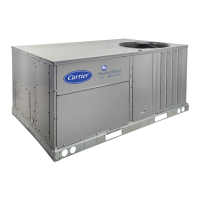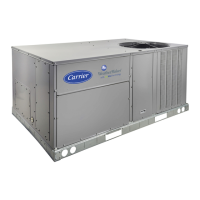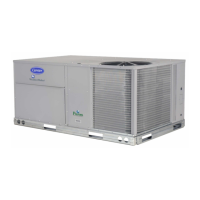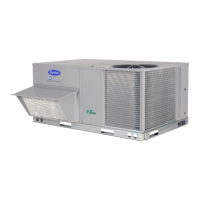Table 64 -- Condenser Fan Staging
FAN RELAY
OFC1,4" (MBB - RELAY 6)
OFC2 (MBB - RELAY 5)
OFC3 C.A1-AUX or C.A2-AUX
OFCI* C.B1-AUX or C.B2-AUX
020-035 036-050
OFM1 OFM1, OFM2
OFM2 OFM3, OFM4
NA NA
NA NA
48/50A UNIT SIZE
051,060
OFM1, OFM2
OFM3, OFM4, OFM5, OFM6
NA
NA
060 with MCHX
OFM4
OFM2
OFM3
OFM1
* For size 60 ton units with MCHX condensers, MBB - Relay 6 drives OFC4 and compressor contactor B1 or B2 auxiliary contacts drive OFC1.
For 060 size units with MCHX condensers, there are four
outdoor fans, two for each independent refrigerant circuit. The
control cycles two stages of outdoor fans for each circuit, one
fan per stage, to maintain acceptable head pressure.
When a circuit A compressor has been colrnnanded on, then
OFC3 is energized via the normally opened auxiliary contacts
on the compressor contactors. The auxiliary contacts are wired
such that turning on either circuit A compressor will energize
OFC3. Contactor OFC3 will remain on until all circuit A com-
pressors have been colrnnanded off. If SCTA is above the
HPSP or if OAT is greater than 75 F, then condenser fan A
(MBB Relay 6) will be energized (CD.EA = ON) turning on
OFC4. Condenser fan A will remain on until all compressors
have been conunanded off, or SCTA drops 40 F below the
HPSP for greater than 2 minutes and OAT is less than 73 F.
When a circuit B compressor has been conunanded on, then
OFC1 is energized via the normally opened auxiliary contacts
on the compressor contactors. The auxiliary contacts are wired
such that turning on either circuit B compressor will energize
OFC1. Contactor OFC1 will remain on until all circuit B com-
pressors have been conunanded off. If SCTB is above the
HPSP or if OAT is greater than 75 F, then condenser fan B
(MBB Relay 5) will be energized (CD.EB = ON) turning on
OFC2. Condenser fan B will remain on until all compressors
have been colmnanded off, or SCTB drops 40 F below the
HPSP for greater than 2 minutes and OAT is less than 73 F.
Failure Mode Operation -- If either of the SCT or DPT sen-
sors fails, then the control defaults to head pressure control
based on the OAT sensor. The control turns on the second fan
stage when the OAT is above 65 F and stages down when OAT
drops below 50 F.
If the OAT sensor fails, then the control defaults to head
pressure control based on the SCT sensors. The control turns
on the second fan stage when the highest active circuit SCT is
above the HPSP and stages down when the highest active cir-
cuit SCT drops 40 F below the HPSP for longer than
2 minutes.
If the SCT, DPT, and OAT sensors have all failed, then the
control turns on the first and second fan stages when any com-
pressor is colrnnanded on.
Compressor current sensor boards (CSB) are used on all
units and are able to diagnose a compressor stuck on (welded
contactor) condition. If the control conunands a compressor off
and the CSB detects current flowing to the compressor, then
the first fan stage is turned on ilrnnediately. The second fan
stage will turn on when OAT rises above 75 F or the highest ac-
tive circuit SCT rises above the HPSP and remain on until the
condition is repaired regardless of the OAT and SCT values.
ECONOMIZER INTEGRATION WITH MECHANICAL
COOLING- When the economizer is able to provide free
cooling (Run Status--cECON--cACTV = YES), mechanical
cooling may be delayed or even held offindefinitely.
NOTE: Once mechanical cooling has started, this delay logic
is no longer relevant.
Economizer Mechanical Cooling Delay -- This type of me-
chanical cooling delay is relevant to the all machine control
types.
If the economizer is able to provide free cooling at the start
of a cooling session, the mechanical cooling algorithin checks
the economizer's current position (Run Status--+
ECON-+ECN..P) and compares it to the economizer's maxi-
mum position (C'onfiguration--+EC'ON--+EC:MX) - 5%.
Once the economizer has opened beyond this point a
2.5-minute timer starts. If the economizer stays beyond this
point for 2.5 minutes continuously, the mechanical cooling
algofithin is allowed to start computing demand and stage
compressors.
Economizer Control Point (Run Status--+VIEW--+EC: C:P)
-- There are 4 different ways to determine the economizer
control point when the economizer is able to provide free
cooling:
If no mechanical cooling is active and HVAC mode = LOW
COOL
EC. C.P = Seq_oints--+SA.L 0 + Inputs"-+RSET-+SA.S.R
If no mechanical cooling is active and HVAC mode = HIGH
COOL
EC. C.P = Seq_oints -+SA.HI + Inputs" -+RSET-+SA.S.R
When the first stage of mechanical cooling has started
EC.C.P = 53 F plus any economizer suction pressure reset
applied
When the second stage of mechanical cooling has started
EC.C.P = 48 F plus any economizer suction pressure reset
applied
Heating Control -- The A Series (_l,fortLink TM con-
trol system offers control for 3 different types of heating systems
to satisfy general space heating requirements: 2-stage gas heat,
2-stage electric heat and multiple-stage (staged) gas heat.
Variable air volume (VAV) type applications (C TYP = 1, 2,
3, or 5) require that the space terminal positions be colrnnanded
to open to Minimum Heating positions when gas or electric
heat systems are active, to provide for the unit heating
system's Minimum Heating Airflow rate.
For VAV applications, the heat interlock relay (HIR) func-
tion provides the switching of a control signal intended for use
by the VAV terminals. This signal must be used to conunand
the terminals to open to their Heating Open positions. The HIR
is energized whenever the Heating mode is active, an IAQ pre-
occupied force is active, or if fire smoke modes, pressurization,
or smoke purge modes are active.
SETT1NG UP THE SYSTEM -- The heating configurations
are located at the local display under Configuration--cHEAT.
See Table 65.
Heating Control Type (HT.CF) -- The heating control types
available are selected with this variable.
0 = No Heat
1 = Electric Heat
2 = 2 Stage Gas Heat
3 = Staged Gas Heat
Heating Supply Air Set Point (HT.SP) -- In a low heat mode
for staged gas heat, this is the supply air set point for heating.
5O

